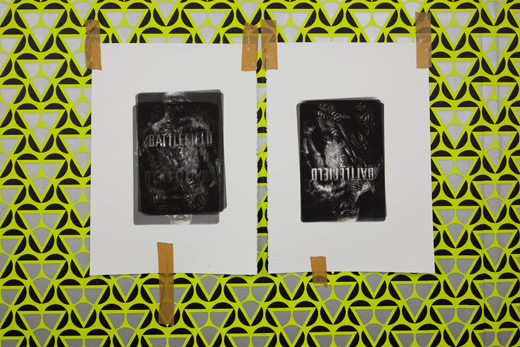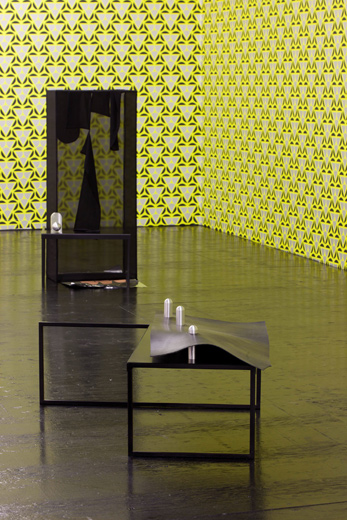ART & ECONOMY IN SCANDINAVIA
Ruba Katrib

Claire Barclay, “Untitled,” 2011. Photo courtesy of Tensta Konsthall.
Lind’s exhibition, Abstract Possible: The Stockholm Synergies was on view this spring at Tensta Konsthall and included work by several artists including Claire Barclay, José León Cerillo, Matias Faldbakken, Walid Raad, Emily Roysdon, and Haegue Yang. The exhibition was the third iteration of Lind’s project, which has been previously shown in different forms at the Konsthall Malmö in Sweden and the Museo Tamayo in Mexico City. The exhibition takes the current interest in abstraction by many contemporary artists and creates parallels to “economic abstraction.” In this sense abstraction can be seen as a withdrawal strategy or commenting upon a sense of mystification towards the current global economy. The most prominent element about the exhibition, which has become a central conversation in any press about the show, is that Lind has also collaborated with Bukowskis, an auction house in Sweden that is funded by Lundin Petroleum, a firm that has been accused of causing war crimes and human rights violations in Sudan. By accepting money from Lundin and associating her own work, that of the artists, and Tensta Konsthall with such a corporation, Lind has come under fire.
Despite Lind’s own position of criticality in relation to Bukowskis — she has argued that she is uncovering the underbelly of funding structures in contemporary art as well as willingly implicating herself — the gesture seems to go too far. In Kunstkritikk, a Nordic-focused art publication, the damnation comes from Lind’s perceived inability to direct the conversation as well as take the heat, calling her actions “deplorable.” The outrage doesn’t seem to come from the fact that Lind is drawing our attention to a general ignorance of the seedy sides of cultural sponsors, but that she actually collaborated with such a corporation. There have been calls for her resignation as well in major Swedish news media coverage of the story.
From my perspective as an outsider, the conversations I have access to seem to skirt an essential point. While Lind is publicly associating herself with a corporation accused of serious and devastating crimes, how many Nordic arts organizations and individual artists are equally in bed with the perceived enemy without realizing or acknowledging it? This association is not only limited to Scandinavia, but anywhere where corporations and even governments fund the arts.

Matias Faldbakken, “Triple Cover Screen Print #2 – 11,” 2011. Photo courtesy of Tensta Konsthall.
I believe that focusing on the perceived divide between public and private strips these urgent questions and debates of their potency. Lind’s project highlighted the fact that one result of a decrease of public funding is that arts organizations in Sweden may have to collaborate with more private sponsors that have questionable activities. On the other hand, Fraser sees the increase in privatization and shrinking public sector in cultural support as inherently damaging to the art system.
In some ways the current condition of the art worlds in Scandinavia can be envied. Artists can focus on making their work and nonprofits have increased financial security so they don’t have to spend all their time fundraising. However, as Lind has made alarmingly evident, the other activities of funders can be at a huge conflict to the ideals and discourses in contemporary art. My final question is if “public” funding is much better? Where do those funds come from? Is it better to take money from governments that are waging wars than from corporations that do the same? When we approach the relationship between art and the economy via the perceived superiority of the public sphere, we could push the debate further if we start instead by questioning our own implication.










